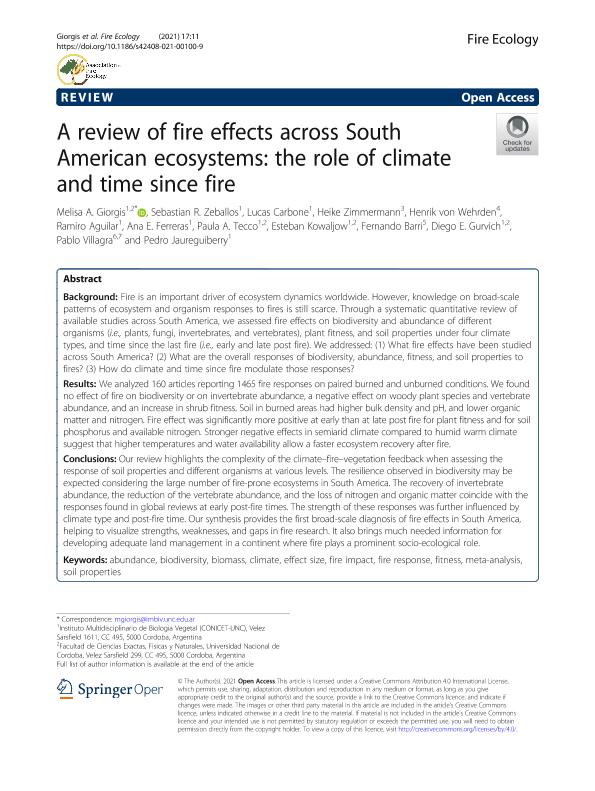Artículo
A review of fire effects across South American ecosystems: The role of climate and time since fire
Giorgis, Melisa Adriana ; Zeballos, Sebastián Rodolfo
; Zeballos, Sebastián Rodolfo ; Carbone, Lucas Manuel
; Carbone, Lucas Manuel ; Zimmermann, Heike; von Wehrden, Henrik; Aguilar, Ramiro
; Zimmermann, Heike; von Wehrden, Henrik; Aguilar, Ramiro ; Ferreras, Ana Elisa
; Ferreras, Ana Elisa ; Tecco, Paula Andrea
; Tecco, Paula Andrea ; Kowaljow, Esteban
; Kowaljow, Esteban ; Barri, Fernando Rafael
; Barri, Fernando Rafael ; Gurvich, Diego Ezequiel
; Gurvich, Diego Ezequiel ; Villagra, Pablo Eugeni; Jaureguiberry, Pedro
; Villagra, Pablo Eugeni; Jaureguiberry, Pedro
 ; Zeballos, Sebastián Rodolfo
; Zeballos, Sebastián Rodolfo ; Carbone, Lucas Manuel
; Carbone, Lucas Manuel ; Zimmermann, Heike; von Wehrden, Henrik; Aguilar, Ramiro
; Zimmermann, Heike; von Wehrden, Henrik; Aguilar, Ramiro ; Ferreras, Ana Elisa
; Ferreras, Ana Elisa ; Tecco, Paula Andrea
; Tecco, Paula Andrea ; Kowaljow, Esteban
; Kowaljow, Esteban ; Barri, Fernando Rafael
; Barri, Fernando Rafael ; Gurvich, Diego Ezequiel
; Gurvich, Diego Ezequiel ; Villagra, Pablo Eugeni; Jaureguiberry, Pedro
; Villagra, Pablo Eugeni; Jaureguiberry, Pedro
Fecha de publicación:
12/2021
Editorial:
Springer Science and Business Media Deutschland GmbH
Revista:
Fire Ecology
e-ISSN:
1933-9747
Idioma:
Inglés
Tipo de recurso:
Artículo publicado
Clasificación temática:
Resumen
Fire is an important driver of ecosystem dynamics worldwide. However, knowledge on broad-scale patterns of ecosystem and organism responses to fires is still scarce. Through a systematic quantitative review of available studies across South America, we assessed fire effects on biodiversity and abundance of different organisms (i.e., plants, fungi, invertebrates, and vertebrates), plant fitness, and soil properties under four climate types, and time since the last fire (i.e., early and late post fire). We addressed: (1) What fire effects have been studied across South America? (2) What are the overall responses of biodiversity, abundance, fitness, and soil properties to fires? (3) How do climate and time since fire modulate those responses? Results: We analyzed 160 articles reporting 1465 fire responses on paired burned and unburned conditions. We found no effect of fire on biodiversity or on invertebrate abundance, a negative effect on woody plant species and vertebrate abundance, and an increase in shrub fitness. Soil in burned areas had higher bulk density and pH, and lower organic matter and nitrogen. Fire effect was significantly more positive at early than at late post fire for plant fitness and for soil phosphorus and available nitrogen. Stronger negative effects in semiarid climate compared to humid warm climate suggest that higher temperatures and water availability allow a faster ecosystem recovery after fire. Conclusions: Our review highlights the complexity of the climate?fire?vegetation feedback when assessing the response of soil properties and different organisms at various levels. The resilience observed in biodiversity may be expected considering the large number of fire-prone ecosystems in South America. The recovery of invertebrate abundance, the reduction of the vertebrate abundance, and the loss of nitrogen and organic matter coincide with the responses found in global reviews at early post-fire times. The strength of these responses was further influenced by climate type and post-fire time. Our synthesis provides the first broad-scale diagnosis of fire effects in South America, helping to visualize strengths, weaknesses, and gaps in fire research. It also brings much needed information for developing adequate land management in a continent where fire plays a prominent socio-ecological role.
Archivos asociados
Licencia
Identificadores
Colecciones
Articulos(IDEA)
Articulos de INSTITUTO DE DIVERSIDAD Y ECOLOGIA ANIMAL
Articulos de INSTITUTO DE DIVERSIDAD Y ECOLOGIA ANIMAL
Articulos(IMBIV)
Articulos de INST.MULTIDISCIPL.DE BIOLOGIA VEGETAL (P)
Articulos de INST.MULTIDISCIPL.DE BIOLOGIA VEGETAL (P)
Citación
Giorgis, Melisa Adriana; Zeballos, Sebastián Rodolfo; Carbone, Lucas Manuel; Zimmermann, Heike; von Wehrden, Henrik; et al.; A review of fire effects across South American ecosystems: The role of climate and time since fire; Springer Science and Business Media Deutschland GmbH; Fire Ecology; 17; 1; 12-2021; 1-20
Compartir
Altmétricas



